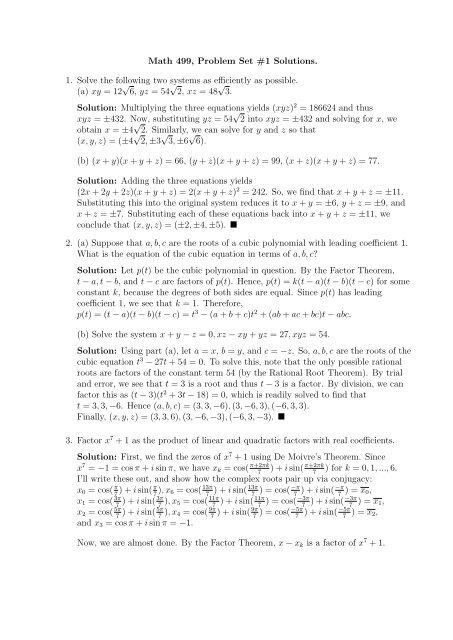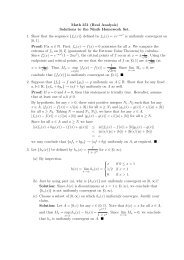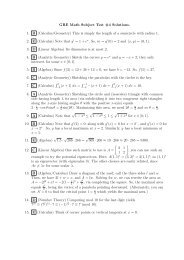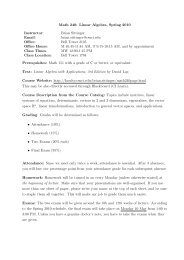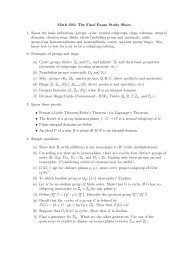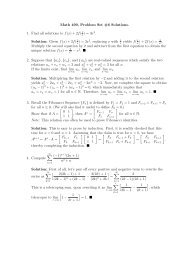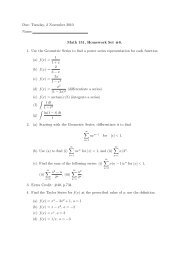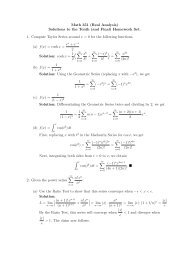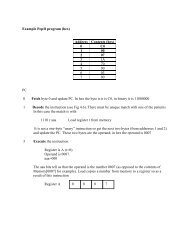Math 499, Problem Set #1 Solutions. 1. Solve the following two ...
Math 499, Problem Set #1 Solutions. 1. Solve the following two ...
Math 499, Problem Set #1 Solutions. 1. Solve the following two ...
Create successful ePaper yourself
Turn your PDF publications into a flip-book with our unique Google optimized e-Paper software.
<strong>Math</strong> <strong>499</strong>, <strong>Problem</strong> <strong>Set</strong> <strong>#1</strong> <strong>Solutions</strong>.<br />
<strong>1.</strong> <strong>Solve</strong> <strong>the</strong> <strong>following</strong> <strong>two</strong> systems as efficiently as possible.<br />
(a) xy = 12 √ 6, yz = 54 √ 2, xz = 48 √ 3.<br />
Solution: Multiplying <strong>the</strong> three equations yields (xyz) 2 = 186624 and thus<br />
xyz = ±432. Now, substituting yz = 54 √ 2 into xyz = ±432 and solving for x, we<br />
obtain x = ±4 √ 2. Similarly, we can solve for y and z so that<br />
(x, y, z) = (±4 √ 2, ±3 √ 3, ±6 √ 6).<br />
(b) (x + y)(x + y + z) = 66, (y + z)(x + y + z) = 99, (x + z)(x + y + z) = 77.<br />
Solution: Adding <strong>the</strong> three equations yields<br />
(2x + 2y + 2z)(x + y + z) = 2(x + y + z) 2 = 242. So, we find that x + y + z = ±1<strong>1.</strong><br />
Substituting this into <strong>the</strong> original system reduces it to x + y = ±6, y + z = ±9, and<br />
x + z = ±7. Substituting each of <strong>the</strong>se equations back into x + y + z = ±11, we<br />
conclude that (x, y, z) = (±2, ±4, ±5). <br />
2. (a) Suppose that a, b, c are <strong>the</strong> roots of a cubic polynomial with leading coefficient <strong>1.</strong><br />
What is <strong>the</strong> equation of <strong>the</strong> cubic equation in terms of a, b, c<br />
Solution: Let p(t) be <strong>the</strong> cubic polynomial in question. By <strong>the</strong> Factor Theorem,<br />
t − a, t − b, and t − c are factors of p(t). Hence, p(t) = k(t − a)(t − b)(t − c) for some<br />
constant k, because <strong>the</strong> degrees of both sides are equal. Since p(t) has leading<br />
coefficient 1, we see that k = <strong>1.</strong> Therefore,<br />
p(t) = (t − a)(t − b)(t − c) = t 3 − (a + b + c)t 2 + (ab + ac + bc)t − abc.<br />
(b) <strong>Solve</strong> <strong>the</strong> system x + y − z = 0, xz − xy + yz = 27, xyz = 54.<br />
Solution: Using part (a), let a = x, b = y, and c = −z. So, a, b, c are <strong>the</strong> roots of <strong>the</strong><br />
cubic equation t 3 − 27t + 54 = 0. To solve this, note that <strong>the</strong> only possible rational<br />
roots are factors of <strong>the</strong> constant term 54 (by <strong>the</strong> Rational Root Theorem). By trial<br />
and error, we see that t = 3 is a root and thus t − 3 is a factor. By division, we can<br />
factor this as (t − 3)(t 2 + 3t − 18) = 0, which is readily solved to find that<br />
t = 3, 3, −6. Hence (a, b, c) = (3, 3, −6), (3, −6, 3), (−6, 3, 3).<br />
Finally, (x, y, z) = (3, 3, 6), (3, −6, −3), (−6, 3, −3). <br />
3. Factor x 7 + 1 as <strong>the</strong> product of linear and quadratic factors with real coefficients.<br />
Solution: First, we find <strong>the</strong> zeros of x 7 + 1 using De Moivre’s Theorem. Since<br />
x 7 = −1 = cos π + i sin π, we have x k = cos( π+2πk ) + i sin( π+2πk ) for k = 0, 1, ..., 6.<br />
7 7<br />
I’ll write <strong>the</strong>se out, and show how <strong>the</strong> complex roots pair up via conjugacy:<br />
x 0 = cos( π) + i sin( π), x 7 7 6 = cos( 13π<br />
13π<br />
−π<br />
−π<br />
) + i sin( ) = cos( ) + i sin( ) = x 7 7 7 7 0,<br />
x 1 = cos( 3π) + i sin( 3π), x 7 7 5 = cos( 11π<br />
11π<br />
−3π<br />
−3π<br />
) + i sin( ) = cos( ) + i sin( ) = x 7 7 7 7 1,<br />
x 2 = cos( 5π) + i sin( 5π), x 7 7 4 = cos( 9π) + i sin( 9π −5π<br />
−5π<br />
) = cos( ) + i sin( ) = x 7 7 7 7 2,<br />
and x 3 = cos π + i sin π = −<strong>1.</strong><br />
Now, we are almost done. By <strong>the</strong> Factor Theorem, x − x k is a factor of x 7 + <strong>1.</strong>
Since (x − x k )(x − x k ) = [(x − cos( kπ)) − i sin( kπ)][(x − cos( kπ)) + i sin( kπ)] =<br />
7 7 7 7<br />
x 2 − (2 cos( kπ ))x + 1, we conclude that <strong>the</strong> desired factorization is<br />
7<br />
x 7 + 1 = (x + 1)(x 2 − (2 cos( π))x + 7 1)(x2 − (2 cos( 2π))x + 7 1)(x2 − (2 cos( 3π ))x + 1). <br />
7<br />
4. If A and B are square matrices of <strong>the</strong> same dimension and AB 2 − A is invertible,<br />
show that BA − A is also invertible.<br />
Solution: Since AB 2 − A is invertible, we have |AB 2 − A| ̸= 0. Since<br />
|AB 2 − A| = |A(B 2 − I)| = |A(B − I)(B + I)| = |A||B − I||B + I| ̸= 0. So, |A| ̸= 0,<br />
|B − I| ̸= 0, and |B + I| ̸= 0. Therefore, |BA − A| = |(B − I)A| = |B − I||A| ≠ 0,<br />
and so BA − A is invertible. <br />
5. Let a, b > 0. Show that lim<br />
n→∞<br />
(a n + b n ) 1/n = max{a, b}.<br />
Solution: Use <strong>the</strong> fact that lim n→∞ c n = 0 when |c| < <strong>1.</strong> If a = b, <strong>the</strong>n this reduces<br />
to lim n→∞ (2a n ) 1/n = lim n→∞ 2 1/n a = 1 · a = a = max{a, b}. Without loss of<br />
generality, now assume that a > b. Then, lim n→∞ (a n + b n ) 1/n =<br />
lim n→∞ [a n (1 + ( b a )n )] 1/n = lim n→∞ a(1 + ( b a )n ) 1/n = a(1 + 0) 0 = a = max{a, b}. <br />
6. Show that <strong>the</strong>re does not exist a differentiable function f : R → R such that<br />
f(f(x)) = e −x for all x ∈ R. (It may be useful to first establish that is f ◦ f has a<br />
unique fixed point, <strong>the</strong>n so does f.)<br />
Solution: First, we show that if x = a is <strong>the</strong> only fixed point of f ◦ f, <strong>the</strong>n x = a is<br />
also <strong>the</strong> only fixed point of f. Let b = f(a), so that f(b) = f(f(a)) = a. Hence,<br />
f(b) = a and f(a) = b, and so we have f(f(b)) = f(a) = b. Since f ◦ f has only one<br />
fixed point, we must have b = a, which implies that f(b) = f(a) = a. That is, a is a<br />
fixed point of f. Moreover, it is <strong>the</strong> only one, because every fixed point of f is fixed<br />
point of f ◦ f, and f ◦ f has only one of <strong>the</strong>m.<br />
Now, suppose that <strong>the</strong>re exists f such that f(f(x)) = e −x . Check that <strong>the</strong>re is only<br />
one root to <strong>the</strong> equation e −x = x; call it a. So, x = a is <strong>the</strong> only fixed point of f ◦ f.<br />
On one hand, since a is a fixed point, <strong>the</strong> Chain Rule gives<br />
(f ◦ f) ′ (a) = f ′ (f(a)) · f ′ (a) = [f ′ (a)] 2 ≥ 0. On <strong>the</strong> o<strong>the</strong>r hand,<br />
(f ◦ f) ′ (a) = −e −x < 0. So, we have a contradiction. .<br />
7. Show that<br />
∫ ∞<br />
1<br />
(<br />
1<br />
3√<br />
t3 + 1 − 1 )<br />
dt converges.<br />
t + 1<br />
Solution: We first of all rewrite <strong>the</strong> integrand before applying <strong>the</strong> Comparison Test.<br />
First of all, we combine <strong>the</strong> fractions toge<strong>the</strong>r.<br />
1<br />
3√<br />
t3 + 1 − 1<br />
t + 1 = (t + 1) − 3√ t 3 + 1<br />
(t + 1) · 3√ t 3 + 1 .
Next, we rationalise <strong>the</strong> numerator via difference of cubes formula:<br />
Simplifying yields<br />
(t + 1) − 3√ t 3 + 1<br />
(t + 1)( 3√ t 3 + 1) · (t + 1)2 + 2(t + 1) 3√ t 3 + 1 + 3√ (t 3 + 1) 2 )<br />
(t + 1) 2 + 2(t + 1) 3√ t 3 + 1 + 3√ (t 3 + 1) 2 .<br />
3t 2 + 3t<br />
(t + 1) 3√ t 3 + 1 · ((t + 1) 2 + 2(t + 1) 3√ t 3 + 1 + 3√ (t 3 + 1) 2 ) .<br />
Next, cancel a common factor:<br />
3t<br />
3√<br />
t3 + 1 · ((t + 1) 2 + 2(t + 1) 3√ t 3 + 1 + 3√ (t 3 + 1) 2 ) .<br />
We can increase its value by eliminating factors from <strong>the</strong> denominator. So, we obtain<br />
1<br />
3√<br />
t3 + 1 − 1<br />
t + 1 <<br />
3t<br />
3√<br />
t3 (t 2 + 2t 3√ t 3 + 3√ (t 3 ) 2 = 1 t 2 for all t > 0.<br />
Since ∫ ∞ dt<br />
converges (to 1), we conclude that <strong>the</strong> integral in question also converges<br />
1 t 2<br />
by <strong>the</strong> Comparison Test.


